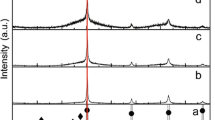Abstract
We study thermal-physical characteristics of nano-sized amorphous tungsten and of its oxide. It is shown that a nano-size amorphous metal gets into a nano-size crystalline state after heating up to temperatures much lower than the half-temperature of melting, which is typical for all nano-size amorphous materials. Phase transition of amorphous nano-size WO2 into crystalline state occurs in the temperature range 350–520°C, while the same transition in case of W takes place in the range 1000–1370°C. The energy released at crystallization of nano-size amorphous metal amounts to 170±25 J/g coinciding practically with the value of specific melting heat of usual tungsten. Such a high additional energy of nano-size amorphous metals above the energy of nano-size crystalline metals is their main peculiarity which widens essentially the range of their practical applications.
Similar content being viewed by others
References
Malkhasyan, R.T., Zhurkin, E.S., and Tunitskii, N.N., Khimiya vysokikh energiy, 1977, vol. 11, p. 400.
Malkhasyan, R.T., Movsesyan, G.L., and Potapov, V.K., Khimiya vysokikh energiy, 1992, vol. 26, p. 8.
Amorfnye metallicheskie splavy (Amorphous Metallic Alloys), Lyuborskii, F.E., ed., Moscow: Metallurgiya, 1983.
Suzuki, K., Fujimori, H., and Hashimoto, K., Amorfnye metally (Amorphous Metals), Moscow: Metallurgiya, 1987.
Malkhasyan, R.T., Method of direct reduction of oxides and obtaining of amorphous metals, Patent of RF, no. 4906334/02/109161 (1990).
Malkhasyan, R.T., Agababyan, E.V., and Karakhanyan, R.K., Khimicheskaya fizika, 1996, vol. 30, no. 3, p. 3.
Malkhasyan, R.T. and Grigoryan, S.L., New mechanism and kinetics of nanoamorphous metals synthesis process, Innovative Processing Ceramics, Glasses, Composite II, USA, Ohayo Ceramic Transactions, 1999, vol. 94. p. 455.
Suslick, K.S., Hyeon, T., and Fang, M., Chem. Mater., 1996, vol. 8, p. 2172.
Kesvan, V. et al., Pure and Applied Chemistry, 2001, vol. 73, p. 85.
Kumar, G., Tang, H.X., and Schreers J., Nature, 2009, vol. 457, p. 868.
Chen, C. and Spaepen, F.J., Phys. A, Appl. Phys., 1991, vol. 69, p. 679.
Michaelson, C, Barmak, K., and Weihs, T.P., J. of Physics D: Appl. Phys., 1997, vol. 30, p. 3167.
Malkhasyan, R.T. and Grigoryan S.L., Non-equilibrium Technology of Obtaining Nanoamorphous Metals, Proc. of MRS FALL Meeting, Boston, USA, 2003. p. 171.
Kabalyan, Yu.K., Grigoryan, S.L., and Malkhasyan, R.T., Khimicheskiy zhurnal Armenii, 2012, vol. 65, p. 239.
Author information
Authors and Affiliations
Corresponding author
Additional information
Original Russian Text © R.T. Malkhasyan, R.V. Arutyunyan, L.V. Kamaeva, E.I. Salamatov, 2014, published in Izvestiya NAN Armenii, Fizika, 2014, Vol. 49, No. 1, pp. 54–61.
About this article
Cite this article
Malkhasyan, R.T., Arutyunyan, R.V., Kamaeva, L.V. et al. Phase transition of nano-sized amorphous tungsten to a crystalline state. J. Contemp. Phys. 49, 34–38 (2014). https://doi.org/10.3103/S106833721401006X
Received:
Published:
Issue Date:
DOI: https://doi.org/10.3103/S106833721401006X




